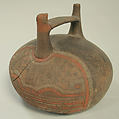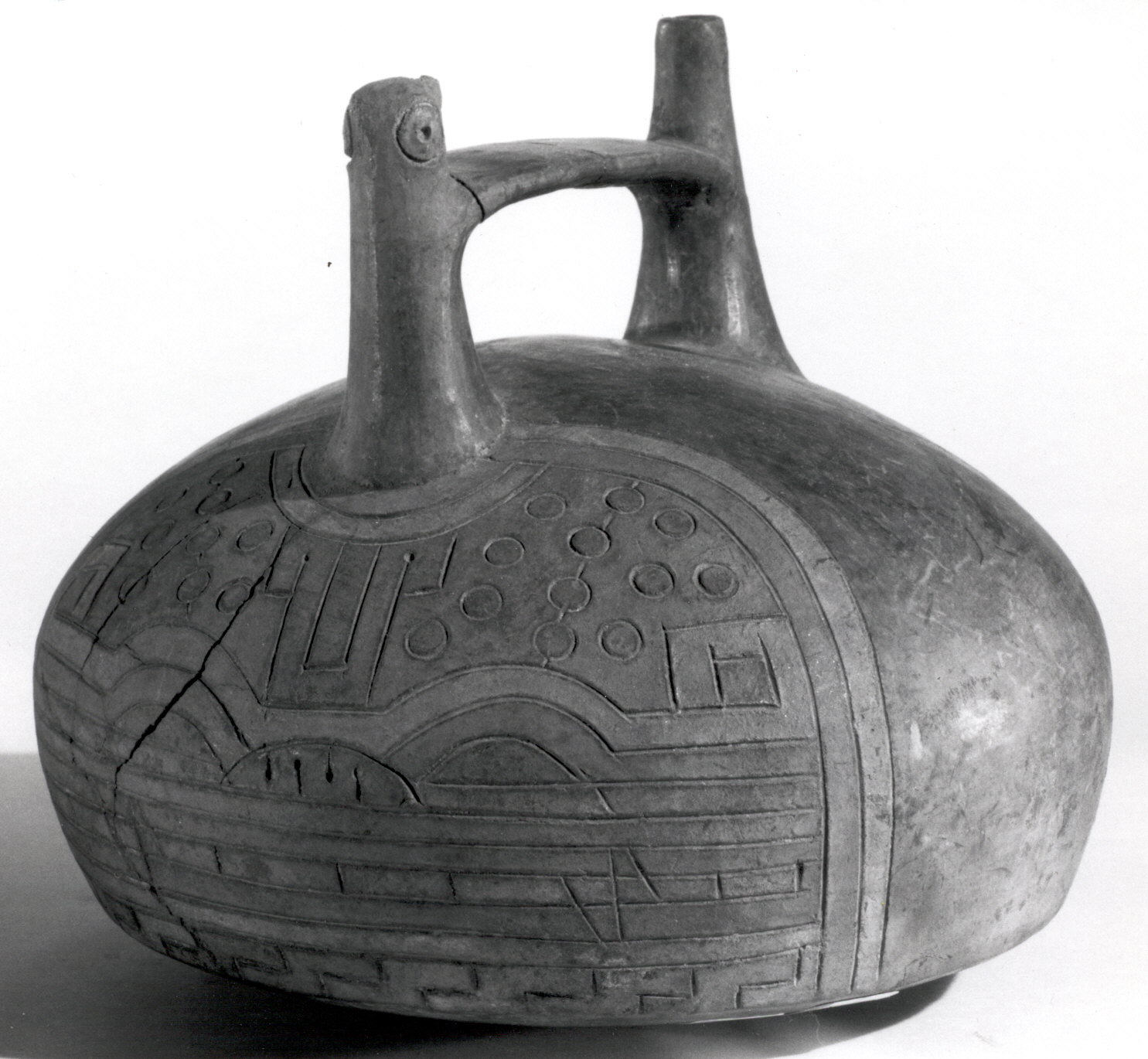Bottle, Feline Face
Not on view
This double-spout and bridge vessel features a bird head spout and an incised feline face on the body of the vessel. These animals feature prominently in the iconography of Paracas art between 8th -4th centuries B.C on the south coast of Peru. The vessel’s form is frequently found among ceremonial vessels, and the spout with the modeled head of a small bird head is painted red, and beak, painted yellow. This spout is closed, only the other, undecorated spout would have been functional for liquids to be poured into and out of the vessel. Below the bird spout on the body of the vessel is a feline face. Created by incisions in the vessel’s wet clay, prior to firing, the feline’s nose, eyes, and mouth with fangs are defined by thin and ovular lines. Small circles are located above the feline’s eyes. Finally, the feline’s face is highlighted by the application of red, white, and brown paints. These pigments, as well as those on the bird spout were applied after the vessel was fired, a technique known as post-fire resin painting. Another vessel in the MMA collection, 1979.206.1148 has a similar feline motif as found this vessel. Feline iconography was fairly common in the Paracas visual record, anthropomorphic feline representations abound on stone works, masks, textiles, and more.
This ceremonial vessel was likely recovered in a Paracas funerary context. Paracas society practiced a funerary tradition that interred their dead in mummy bundles. Deceased individuals were placed in baskets and wrapped in multiple layers of rich textiles, with adornments such as jewelry, food, and pottery. The textiles that have come from this burial tradition are exceptionally well-made in both the fineness of their construction and the bright, complex patterns that adorn them – patterns that regularly include feline and bird figures. While some of these burial items may have been used in daily life, many, like the textiles were likely produced for burial. This double-spout and bridge bottle could very well have held libations for the deceased, or been representative of goods essential for the afterlife.
Emily Field, M.A., Bard Graduate Center, 2017
References and Further Reading
DeLeonardis, Lisa. “Encoded Process, Embodied Meaning in Paracas Post-Fired Painted Ceramics,” Making Value, Making Meaning: Techné in the Pre-Columbian World, edited by Cathy Costin, pp. 129-166. Washington D.C.: Dumbarton Oaks Research Library and Collections, 2016.
Deleonardis, Lisa. “Interpreting the Paracas Body and its value in Ancient Peru.” In The Construction of Value in the Ancient World, edited by John K. Papadopoulos and Gary Urton, pp. 197-217. Los Angeles: Cotsen Institute of Archaeology, University of California, Los Angeles, 2016.
Knudson, Kelly J., Ann H. Peters, Elsa Tomasto Cagigao. Paleodiet in the Paracas Necropolis of Wari Kayan: carbon and nitrogen isotope analysis of keratin samples from the south coast of Peru. Journal of Archaeological Science 55 (2015): 231-243
Paul, Anne. “Paracas Necropolis Bundle 89: A Description and Discussion of its Contents” in Paracas Art and Architecture: Object and Context in South Coastal Peru, edited by Anne Paul, pp. 172-221. Iowa City: University of Iowa Press, 1991.
Peters, Anne. Funerary Regalia and Institutions of Leadership in Paracas and Topara. Chungara, Revista de Antropolgia Chilena 32 no 2 (2000): 245-252.
Proulx, Donald A. “Paracas and Nasca: Regional Cultures on the South Coast of Peru” in Handbook of South American Archaeology, edited by Helaine Silverman and William Isbell, pp. 563-584. Springer, 2008.
Sawyer, Alan. Ancient Peruvian Ceramics: The Nathan Cummings Collection. New York: The Metropolitan Museum of Art, 1966.
Silverman, Helaine. Ancient Peruvian Art: An Annotated Bibliography. Reference Publications in Art History, New York: G.K. Hall & Co., 1996.
Vreeland, James M. "Mummies of Peru" in Mummies, disease & ancient cultures, edited by Aida Cockburn, Eve Cockburn and Theodore A. Reyman, pp. 154-189. Cambridge, Cambridge University Press, 1998.
Due to rights restrictions, this image cannot be enlarged, viewed at full screen, or downloaded.
This artwork is meant to be viewed from right to left. Scroll left to view more.



